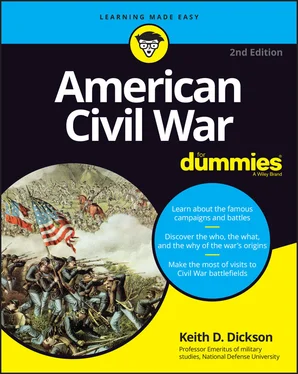Keith D. Dickson - American Civil War For Dummies
Здесь есть возможность читать онлайн «Keith D. Dickson - American Civil War For Dummies» — ознакомительный отрывок электронной книги совершенно бесплатно, а после прочтения отрывка купить полную версию. В некоторых случаях можно слушать аудио, скачать через торрент в формате fb2 и присутствует краткое содержание. Жанр: unrecognised, на английском языке. Описание произведения, (предисловие) а так же отзывы посетителей доступны на портале библиотеки ЛибКат.
- Название:American Civil War For Dummies
- Автор:
- Жанр:
- Год:неизвестен
- ISBN:нет данных
- Рейтинг книги:4 / 5. Голосов: 1
-
Избранное:Добавить в избранное
- Отзывы:
-
Ваша оценка:
- 80
- 1
- 2
- 3
- 4
- 5
American Civil War For Dummies: краткое содержание, описание и аннотация
Предлагаем к чтению аннотацию, описание, краткое содержание или предисловие (зависит от того, что написал сам автор книги «American Civil War For Dummies»). Если вы не нашли необходимую информацию о книге — напишите в комментариях, мы постараемся отыскать её.
American Civil War For Dummies,
American Civil War For Dummies
American Civil War For Dummies — читать онлайн ознакомительный отрывок
Ниже представлен текст книги, разбитый по страницам. Система сохранения места последней прочитанной страницы, позволяет с удобством читать онлайн бесплатно книгу «American Civil War For Dummies», без необходимости каждый раз заново искать на чём Вы остановились. Поставьте закладку, и сможете в любой момент перейти на страницу, на которой закончили чтение.
Интервал:
Закладка:
The South’s view of the election
Here’s how the South analyzed the results of the election. The Republicans won 180 electoral votes. This meant that even if only one candidate had opposed Lincoln, with the entire South united in support, Lincoln would still have won the election. The South simply lacked the electoral votes to offset the advantage of the Northern states.
Clearly, Southern political power had disappeared, and the Republican Party now could dominate the House and the presidency at will. There would be no congressional guarantees of slavery or protection of Southern rights coming from a House of Representatives dominated by the North. Without any words of conciliation coming from the Republicans, many Southerners in the cotton South feared the worst and began to contemplate the last option they believed they had left — leaving the Union.
Chapter 3
Secession and War: 1860–1861
IN THIS CHAPTER
 Understanding the two phases of secession
Understanding the two phases of secession
 Seeing two U.S. presidents deal with the same crisis
Seeing two U.S. presidents deal with the same crisis
 Creating the Confederate States of America
Creating the Confederate States of America
 Viewing Fort Sumter as a critical symbol for both nations
Viewing Fort Sumter as a critical symbol for both nations
After the election of 1860, only a few Southern states took the drastic step of secession. The actions of James Buchanan, the outgoing president, and Abraham Lincoln, the incoming president, would determine whether other Southern states would follow. With very few options and time running out, both men sought to satisfy two conflicting conditions at the same time — to assert the rights of the United States and to avoid war.
On the other side, the seceded states created the Confederate States of America. Although wanting to leave the Union peacefully, the new president of the Confederate States of America, Jefferson Davis, was not afraid of fighting for his new nation’s independence. For both the United States and the Confederate States of America, Fort Sumter became the dominant symbol of each nation’s prideful determination not to back down.
The First Secession: South Carolina and the Lower South
On December 20, 1860, 169 delegates of the state of South Carolina met in Charleston to consider leaving the Union. The convention was organized to mimic the first state convention that assembled for voting to join the United States in 1788. The logic of secession went like this: Each state was sovereign after independence from Great Britain. In 1788, the states entered into a federal union under the Constitution voluntarily. The Constitution was thus a compact, an agreement of sovereign, independent, and self-governing states allowing the central government to have specific powers as outlined in the Constitution. According to the Tenth Amendment, all other power resided with the states. Therefore, any state, if it so desired, could voluntarily leave the Union (secede) and could become a sovereign state again. This was not a rebellion, the South Carolina delegates insisted, but a legal act.
Given the climate after the election of 1860, and the growing fear of what the Republican Party would do to the South after taking control of the government in March when the new president was inaugurated, South Carolina took the first drastic step to dissolve its fraternal bonds with the United States. To the surprise of many Southerners, there was no reaction. After all of the emotionalism, the threats, and the sense of high purpose enmeshed in their world-shaking event, nothing happened. The people of South Carolina must have felt a bit sheepish and uneasy in the roaring silence coming from the federal government. Congress, with its members divided along sectional lines, could take little action, even if it wanted to and President Buchanan had no interest in making waves at the moment. The new citizens of South Carolina also felt a bit lost, lacking any means whatsoever to function independently. The newly declared nation awaited help from her sister states in the lower South, or some indication from Washington. That help came quickly and raised morale higher. Mississippi voted on January 9, 1861, to secede. Two more days passed with two more states, Florida and Alabama, leaving the Union. By the first of February, Georgia, Louisiana, and Texas had also voted themselves out. These states of the lower South had the most to lose from a national government controlled (probably permanently) by Republicans hostile to slavery and condemning the institution to a slow death, which meant eventual economic ruin and social chaos.
The rationale for secession can be summed up in one sentence taken from the Mississippi ordinance of secession: “Our position is thoroughly identified with the institution of slavery — the greatest material interest of the world.” The key words here are “material interest.” Slavery was the basis of the cotton economy, the greatest generator of wealth in the world. These seven states were not willing to risk their wealth, economic security, and social dominance on the Republican-dominated government. This material interest is highlighted by the fact that whites in these states made up only 32% of the South’s total population. Slaves in these states made up 47% of the total slave population. In fact, in Mississippi and South Carolina (the first two states to secede) the enslaved population actually exceeded the white population.
Building a New Nation: The Confederacy
These newly independent states decided to unite in another compact, one more to their liking. A new Constitution was quickly adopted, very much like the original (except for ironclad guarantees of slavery, a six-year term for the president, and increased power to the sovereign states). On February 18, a new nation, the Confederate States of America, was established in Montgomery, Alabama.
Jefferson Davis, former Mississippi senator, heroic Mexican-American War veteran, one-time secretary of war, and strong supporter of Southern rights, became the first president. One of Davis’s first acts as president was to call for 100,000 volunteers to serve the new Confederacy as soldiers for a period of 12 months. Davis didn’t anticipate trouble, but he wasn’t going to take any chances.
As a matter of course, the new Confederacy began taking control of all federal property within its territory. Military installations, post offices, and customs houses came routinely under control of the Confederate government. All but the two most important pieces of federal property, Fort Pickens at Pensacola and Fort Sumter at Charleston, fell under Confederate control. A few days earlier, the delegates who had formed the new government met in session as the first Confederate Congress and authorized the use of force, if necessary, to remove U.S. troops from Fort Sumter and Fort Pickens. For the new Confederacy, Sumter was a bone in its throat. As long as Sumter remained in the hands of the United States, the new government had little claim to legitimacy as an independent country.
WORDS HAVE MEANING
The choice of words is very important; after all, a lot of thought should go into what you name your new country. It has to have significant meaning. So why the word “Confederate”? The Southern states in forming a new government harkened back to the original document that first created the United States in 1781 — the Articles of Confederation. To protect the states from a too-powerful central government, the Articles clearly outlined that the powers of the individual states were dominant. In fact, the Articles only pledged the states to enter into “a firm league of friendship.” It was this spirit of the Confederation that led to the naming of the Confederate States of America. The creation of the Confederacy can be seen as a conservative revolutionary act, intended to go back to the original form of American government.
Читать дальшеИнтервал:
Закладка:
Похожие книги на «American Civil War For Dummies»
Представляем Вашему вниманию похожие книги на «American Civil War For Dummies» списком для выбора. Мы отобрали схожую по названию и смыслу литературу в надежде предоставить читателям больше вариантов отыскать новые, интересные, ещё непрочитанные произведения.
Обсуждение, отзывы о книге «American Civil War For Dummies» и просто собственные мнения читателей. Оставьте ваши комментарии, напишите, что Вы думаете о произведении, его смысле или главных героях. Укажите что конкретно понравилось, а что нет, и почему Вы так считаете.












